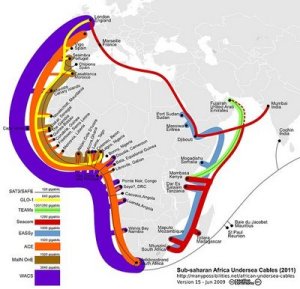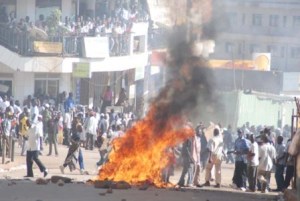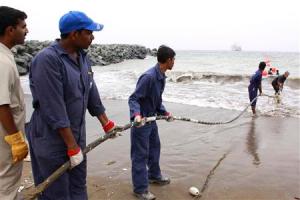Nairobi — East Africa may have received the first undersea fiber optic cable a month ago but it is emerging there is no requisite infrastructure to enable Seacom go deeper into the hinterland.
The EastAfrican has established that in Kenya and Tanzania — on whose coastlines the cable was simultaneously switched on in Mombasa and Dar es Salaam by Presidents Mwai Kibaki and Jakaya Kikwete respectively — faster Internet connectivity still remains out of reach while landlocked neighbours relying on the two countries for connections could even take longer to experience broadband connectivity.
According to Africa Online, one of the ICT firms linking consumers to the fibre-optic cable, Kenya, the region’s natural highway, has only one terrestrial link to the undersea cable — the one operated by Kenya Data Network (KDN) — which is already overwhelmed by traffic, leading to uneven connection speeds.
Africa Online general manager in Kenya, Ken Munyi, said that due to high traffic, the country requires at least three links so that in case one jams, providers can switch to the next seamlessly.
Until that happens, the providers may have to invest in back-up satellite capacity and pass additional costs to users”, he said.
Africa Online has operations in Kenya, Uganda and Tanzania.
Last week, The EastAfrican talked to its regional managers, who were in Nairobi for a company conference, about why the landing of the fabled fibre optic cable whose arrival is yet to make a difference in either pricing or speed.
Mr Munyi said the experience of his firm had brought into focus the unpreparedness of the region to embrace the technology, which was launched with so much hype that consumers had come to expect not only faster telecommunications but cheaper too. Unfortunately, the consumers did not realise that there is more to the cable than landing in Mombasa.
“Development of in-country telecommunication infrastructure, local content, growth and appetite for services other than browsing and e-mail, and regulation aimed at enforcing competition and ensuring the quality of service are all critical if the region is to realise the effect of this important development,” Mr Munyi said.
He said the existing IT security systems need to be alert to the dangers inherent in the new broadband era.
“It is perhaps time we qualified the benefits to the different players and articulated what is achievable now and what will have to wait till the necessary infrastructure is in place,” he said.
Critical here is last-mile connectivity — the link between the user and service provider. Applying the analogy of “a chain is only as strong as its weakest link,” it becomes apparent that despite connecting to the fibre at the landing point, the other components of the network are weak, unreliable and insufficiently supported.
“The international cable system, national cable system and last-mile link must all be optimised to deliver quality services,” Mr Munyi said.In Tanzania, said Africa Online manager Stanley Ayittah, despite the switching on of the cable, things are yet to move since the in-country infrastructure — the metro-ethernet — is not ready.
Telekom Tanzania, which undertook the responsibility of delivering the technology to users, is yet to switch the metro-ethernet and has not made public when it will do so. But testing is said to be going on.
Mr Munyi, however, said that Kenya is way ahead of its neighbours — already Internet speeds have picked up. He added that once the other two terrestrial links come on board, things would improve.
These links are expected from Orange and Jamii Telcom. While Orange is reported to have its infrastructure ready for the link, it is waiting for The East African Marine System (Teams) cable, in which it is a shareholder.
The Teams cable is expected to land in November, when both Jamii and Orange will switch on their links, giving providers and users the much-anticipated increase in bandwidth and speed.
The Africa Online managers also said that regulators have to adjust frequency policies to enable wireless networks to carry more capacity. Limiting frequencies to 15MHz will result in networks that cannot be optimally fine-tuned to meet market demand.
By limiting the frequencies, a Wimax network that is manufactured to support throughputs of 80+mbps (megabits per second) is limited to, say, 20mbps.
In the short-term, limited satellite bandwidth will be retained for redundancy in case of fibre-optic cable failure.
The region, Mr Ayitta added, is in its infancy with regards to the access to the fibre and it is too early to compare it with West and Southern Africa, that were hooked up five to six years ago.
Throughout the region, Africa Online’s regional managers say, most of the investment in last-mile connectivity is concentrated in the large urban areas, where majority of the current users reside.
The GSM players and fixed national operators have attempted to expand data services to rural areas and though these services may not be the same in all areas, they are a step in the right direction. Initiatives such as “ICT Villages” will also play a role in taking the services to the masses.
But unless there is direct government investment in opening up such villages, investments in different areas will remain driven by market forces.
Governments need to embrace ICT as part of the regional development agenda, as an enabler of policy implementation in all sectors — agriculture, security, health, public services, and education.
Players in the region also need to work hard at local content generation to stimulate demand for connectivity.




